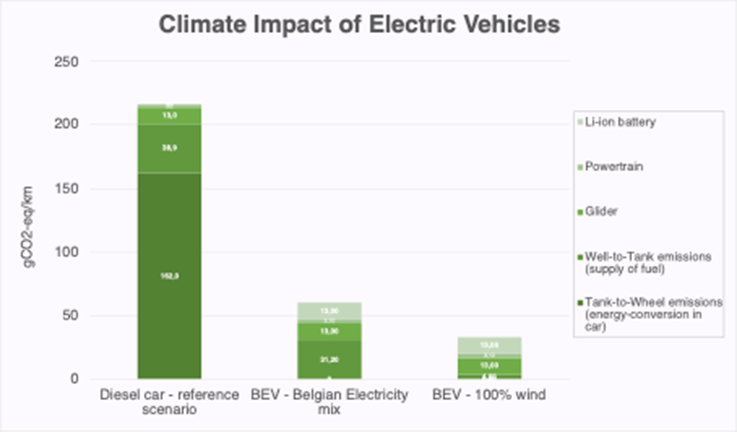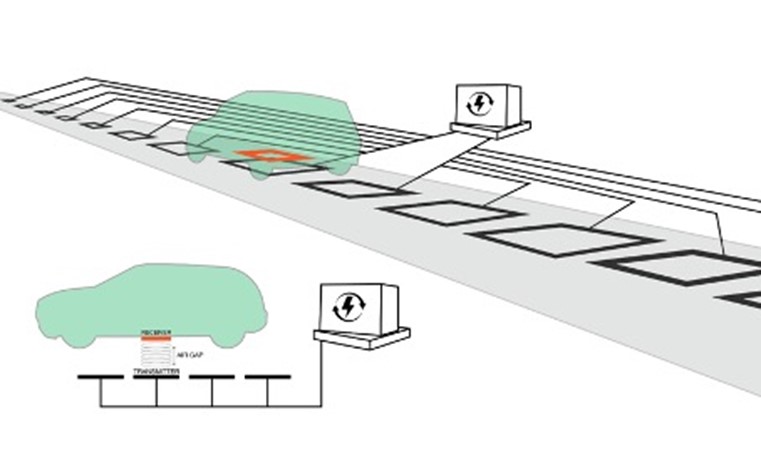Yanaika obtained an Msc in Bioscience engineering with a focus on Environmental Technology. She then deepened her knowledge on climate change through a second Msc in Carbon Management at the University of Edinburgh.
Charging While Driving: The Future?

As electric vehicles rise to tackle the challenge of decarbonizing the transportation sector, range anxiety continues to be one of the key bottlenecks of the technology. Various technologies are emerging that may offer solutions. One of them is dynamic inductive charging, a technology that could allow our batteries to charge while driving…
Transport Emissions in Belgium
In Belgium, the transportation sector accounts for 22% of our national greenhouse gas emissions. Two-thirds of our country’s fleet consists of passenger cars, which are responsible for 54% of these emissions. Trucks and buses make up only 16% of our fleet, yet they are responsible for 41% of our transport emissions, emphasizing the need to decarbonize heavy vehicles as well.
A key solution for decarbonizing transport is electrifying our fleet. With the current Belgian grid, the footprint of electric vehicles over their whole lifecycle is over three times lower than that of their fossil equivalents, and the impact continues to reduce as grids become cleaner.

Figure 1: Source: De Klimaatschok by Geert Noels, Kristof Eggermont and Yanaika Denoyelle based on Messagie, M. (2021). Life Cycle Analysis of the Climate Impact of Electric Vehicles
Nevertheless, electric driving comes with its downsides, such as access to charging infrastructure, range anxiety, cost, and the supply of critical materials for large-scale production of batteries. Key concerns from buyers are visualized in the graph below. A dream solution to a few of these challenges would be the ability to wirelessly charge our vehicles on-the-go.

Figure 2: Source: Deloitte 2018
The Idea Behind Dynamic Wireless Charging
Imagine key highways between cities and countries being adapted so that electric vehicles charge while driving. This way, range improves dramatically, and driving for a holiday in the south of France with an EV becomes much more attractive. Implementing this technology on busy trade routes could be a game-changer for heavy vehicles as well. Trucks transporting goods face the same challenges regarding range anxiety and high costs, but these concerns are magnified: due to their weight, these trucks need significantly larger batteries, which take longer to charge. If, however, trucks are charged en route, the required battery size can be reduced. The battery, in turn, is a significant part of the cost of a vehicle: about 30-40% of the cost of an EV is the battery. A final benefit is that charging while driving can reduce peak electricity consumption. Generally, we charge our vehicles once we return from work, which is also when we typically turn on our dishwasher or put in some laundry. By charging on-the-go, this peak can be more evenly distributed throughout the day, reducing pressure on our grid.
How Does Inductive Charging Work?
Dynamic inductive power transfer systems, or DIPT, represent a possible solution to vastly increase electric vehicle range by embedding mechanisms in the road that wirelessly charge the battery when you drive over them. The technology operates similarly to wireless phone chargers, though it is just a tad more complex. Transmitters connected to a power source are embedded into a lane, and a pad attached to your vehicle receives energy while driving over these transmitters.

Figure 3: Source: Econopolis Strategy, Yanaika Denoyelle
In essence, electricity runs through the transmitters, powered by a base station. Within the transmitter, the electricity generates magnetic fields, which then transfer this power to the receiving pad connected to the car’s battery.
Is Inductive Charging Safe?
Wireless charging makes use of electromagnetic fields, and clearly, the scale and the power of these fields are larger than those used for, for example, wireless phone chargers. It is, therefore, important to study the safety for passengers and nearby wildlife.
Around the world, rigorous standards are already in place to determine safe boundaries on field densities, one of which is provided by the International Commission on Non-Ionizing Radiation Protection. Dynamic inductive charging has been tested and shown to remain within this safe boundary, among others, by Flanders Drive (now Flanders Make).
One key component to ensure this safety is a shield that is positioned above the receiver pad. This shield can work in different ways. The passive shield operates like a screen that essentially makes the radiation “bounce back” to the receiver pad, thereby increasing the efficiency of the power transfer and ensuring safety for passengers. Active (and reactive) shields work similarly to noise-cancelling headphones, they intentionally produce opposing fields to the ones being received, which cancels them out.
What’s The Downside?
As with most new innovations, there are some key bottlenecks slowing down the growth of on-the-go inductive charging.
First, to achieve high efficiencies, it is important for the receiver pad on the vehicle to be perfectly aligned with the transmitter on the road. Especially at high speeds (greater than 70 km/h), this requires a lot of concentration from the driver. Automation can be a game-changer in addressing this challenge, where the car adjusts its position for optimal alignment. Similar features, for example automated steering to keep within a lane, are already present in commercial cars. Furthermore, the length of the air gap between the receiver and transmitter pad should be kept to a minimum to prevent energy losses. This raises the question: how does the efficiency of dynamic inductive charging compare to conventional plug-in charging? A typical level 2 charger you may have at home transfers about 83-94% of the energy from the grid to the battery. Inductive stationary charging- where the car charges through induction while parked- achieves similar efficiencies[1]. Now onto dynamic inductive systems: The FABRIC pilot project that ran between 2014 and 2017 expects efficiencies between 80 and 90% are achievable. More recently, the Arena Del Futuro project in Italy tested a 1-kilometer loop and claimed it could achieve efficiencies that match fast chargers. In the research done by Flanders Make, efficiencies of over 90% were reported, both for passenger cars and a buses.
The second bottleneck is, of course, the cost. On-the-go wireless charging requires significant interventions in infrastructure, as the coils need to be embedded into roads. As such, the technology comes with a high price tag. Current estimates place the cost at a minimum and maximum of 0.4 and 2.7 million euros per kilometer, respectively. This means that an electrified road from Brussels to the Provence would cost between 400 and 2,700 million euros.
As of yet, little to no electrical vehicles are equipped with receiver pads, making retrofitting a necessity. However, this is likely to change for new vehicles, as wireless charging while parked requires receiver pads as well, and this technology is gaining traction.
A lot of the gains will be found in smart planning, a Swedish study[2] found that electrifying 25% of its roads, specifically the busiest routes, could reduce needed battery size with 33% at best. This reduction in battery costs could even offset the cost of implementation the electrified roads for users.
The Future of On-The-Go Charging?
Companies including Volvo, Toyota and Stellantis are active in this emerging technology. Quite a few countries have or are experimenting with this technology, including Belgium, the US, and most notably Sweden. Sweden believes this technology will be key to decarbonizing trucks and busses. By 2026, a 21-kilometer stretch of motorway will be permanently electrified, and if successful it may be expanded to 3,000 km by 2035.
Time will tell if this technology can become an economically competitive addition to electric driving. It is clear, though, that innovative solutions like this will play a key role in the climate transition. Today, we’re only at the beginning of the path to net-zero, and it is hard to imagine just how much innovative clean technologies will improve climate solutions like electric vehicles and accelerate the sustainable transition. Of course, we can’t just rely on technology to reach net-zero, but within these technologies lie interesting opportunities for businesses and countries to pioneer clean solutions and use the transition to create ecological, economic, and social welfare.
-------------------------
[1] Mohamed, Ahmed AS, et al. "A comprehensive overview of inductive pad in electric vehicles stationary charging." Applied Energy 262 (2020): 114584.
[2] Shoman, Wasim, Sten Karlsson, and Sonia Yeh. "Benefits of an Electric Road System for Battery Electric Vehicles." World Electric Vehicle Journal 13.11 (2022): 197.
